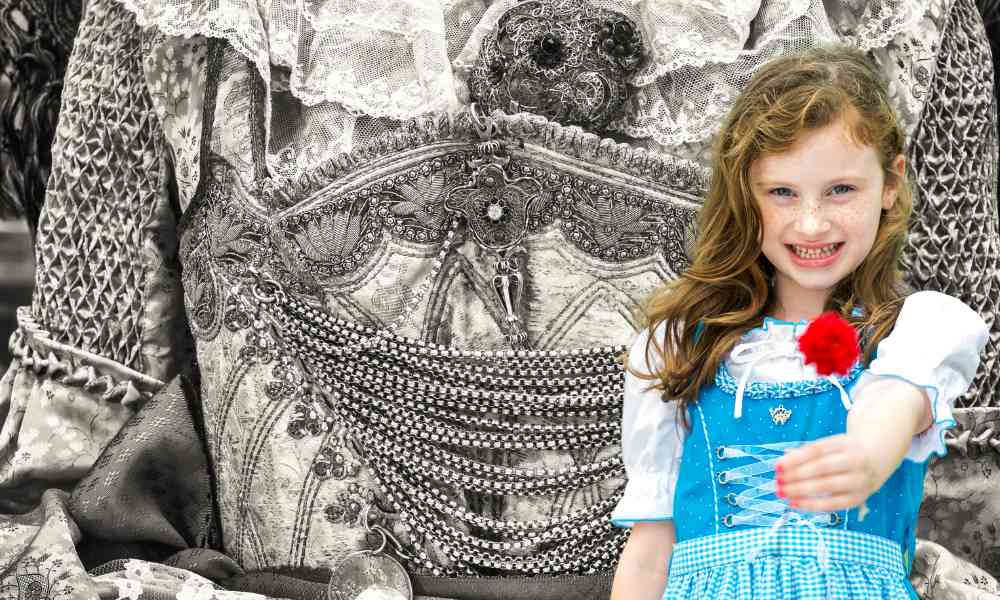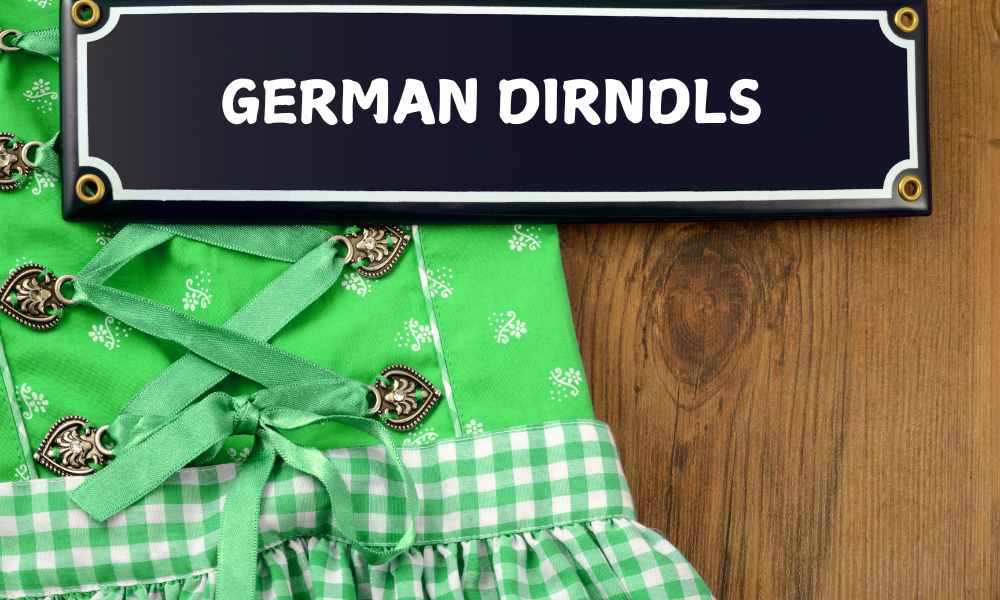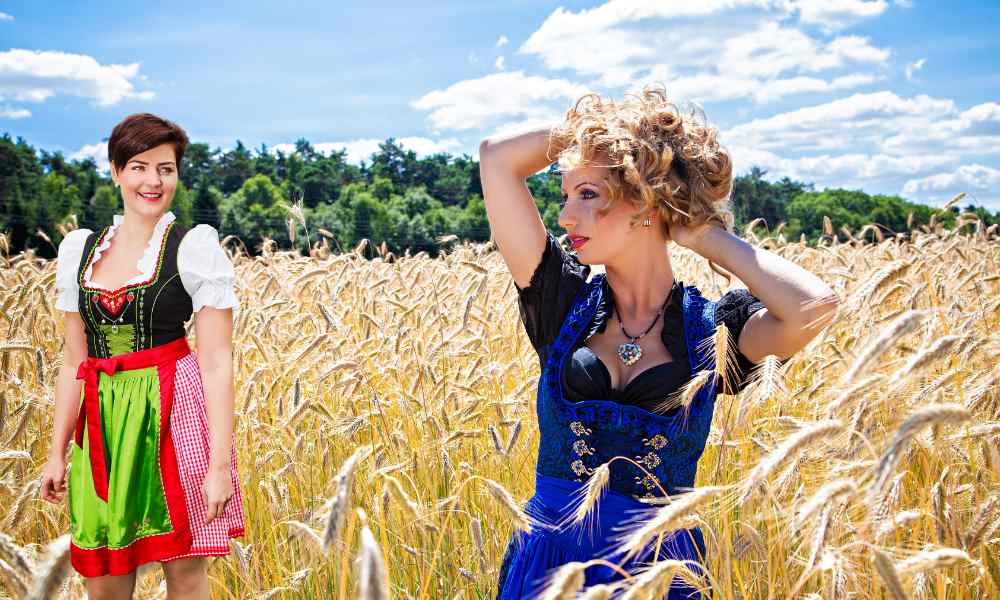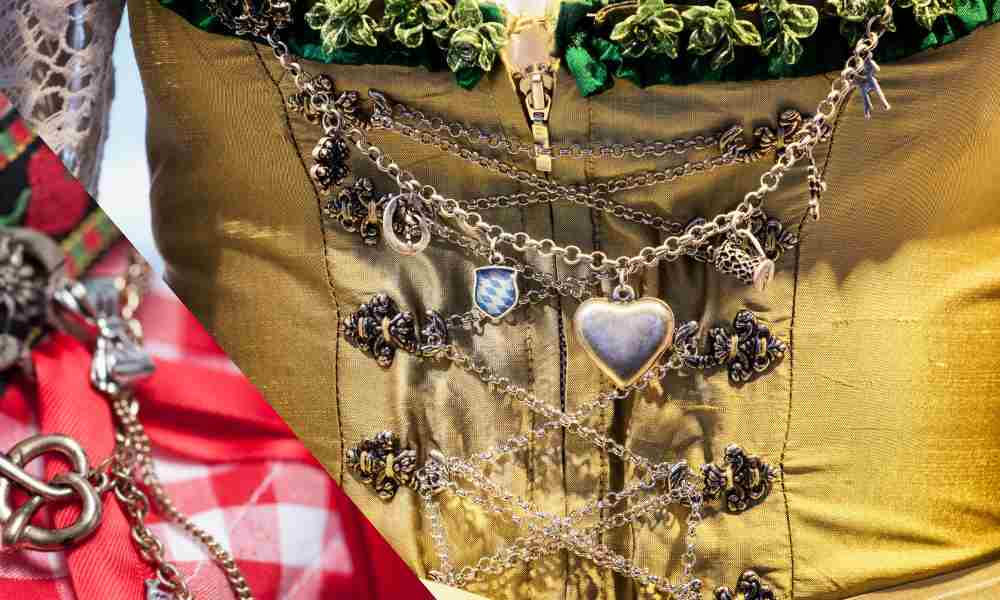Authentic German Dirndls Complete Guide 2024
Step into the fascinating world of German tradition with a dive into the delightful world of German dirndls. These iconic dresses, known for their flirty skirts, fitted bodices, and charming details, are not just fashion statements but imbued with rich history and meaning.
In this captivating article, we will explore the traditions, styles, and symbolism behind dirndls, offering an insightful glimpse into the cultural significance of these garments. Whether you’re a fashion enthusiast, planning a trip to Germany, or simply intrigued by different cultures, this article is sure to captivate your attention.
We will uncover the origins of German dirndls, how they’ve evolved over time, and the various regional styles that exist throughout Germany. From Bavarian classics to modern interpretations, we will showcase the versatility and beauty of dirndls, piquing your interest in exploring this timeless fashion.
So, buckle up and prepare for an enchanting journey into the world of German dirndls. Discover the stories behind these iconic dresses and gain a deeper appreciation for the traditions they represent.

History and origins of German Dirndls
The German dirndls, a quintessential symbol of Bavarian and Austrian culture, has a rich and fascinating history that dates back centuries. These charming dresses have their roots in the traditional garments worn by peasant women in the rural regions of southern Germany and Austria.
In the 19th century, the German dirndls evolved from a practical working-class dress into a fashionable and iconic garment. As industrialisation swept through Europe, the dirndl became a symbol of the romanticised rural life, capturing the attention of the upper classes who sought to emulate the charming aesthetic.
The dirndl’s enduring popularity can be attributed to its versatility and adaptability. Over time, the dress has undergone various transformations, reflecting the changing styles and cultural influences of different eras.
From the simple, utilitarian designs of the past to the more elaborate and ornate versions of today, the dirndl has remained a beloved part of German and Austrian cultural identity.
Traditional elements of a German Dirndls
At the heart of the dirndl lies a rich tapestry of traditional elements that have been carefully woven into its design. The most distinctive feature of a dirndl is its fitted bodice, known as the “Mieder,” which is often adorned with intricate embroidery, lace, or ribbons. This bodice is typically paired with a full, pleated skirt that flares out from the waist, creating a flattering and feminine silhouette.
The apron, or “Schürze,” is another integral component of the traditional dirndl. This small, decorative apron is worn over the skirt and can be tied in a specific way to convey the wearer’s marital status. For example, a bow tied on the right side indicates that the woman is unmarried, while a bow tied on the left signifies that she is married.
The dirndl’s sleeves, known as the “Ärmel,” also hold cultural significance. The length and style of the sleeves can vary depending on the region, with some featuring puffed or ruffled designs, while others have a more streamlined appearance.
The neckline, or “Ausschnitt,” is another area where regional differences can be observed, with some dirndls featuring a square or V-shaped neckline, while others have a more rounded or high-necked design.
Regional variations in German Dirndls
One of the captivating aspects of the German dirndls are the rich diversity of regional styles that can be found throughout Germany and Austria. Each area has its own unique interpretation of the traditional dress, reflecting the local customs, textiles, and aesthetic preferences.
In the Bavarian region, for instance, the dirndl is known for its vibrant colours, such as deep reds, blues, and greens, often paired with intricate embroidery and lace details. The skirts tend to be fuller and longer, creating a more dramatic silhouette.
In contrast, the dirndls of the Tyrolean region, which spans across Austria and southern Germany, are characterised by a more subdued colour palette, with muted tones of beige, brown, and Gray. These dirndls often feature delicate floral patterns and may have a more fitted, streamlined bodice.
The Swabian region, located in southwestern Germany, is known for its dirndls with distinctive square necklines and wider, more structured bodices. These dresses typically feature intricate embroidery and may incorporate traditional Swabian motifs, such as the “Edelweiss” flower.
Regardless of the regional variations, each dirndl is a testament to the rich cultural heritage and artistry of its place of origin, offering a glimpse into the diverse tapestry of German and Austrian traditions.
The significance of German Dirndls in cultural events and festivals

The dirndl holds a special place in the cultural fabric of Germany and Austria, serving as a symbol of identity, tradition, and community. These iconic dresses are deeply woven into the celebrations and festivals that are a vital part of the local way of life.
One of the most well-known events where dirndls take centre stage is the world-famous Oktoberfest, held annually in Munich, Germany. During this vibrant celebration of Bavarian culture, women don their finest dirndls, often in the traditional Bavarian colours, and gather with friends and family to enjoy the festivities.
The dirndl becomes a unifying element, connecting people from all walks of life and creating a sense of shared heritage.
Beyond Oktoberfest, dirndls are a staple sight at numerous regional festivals and celebrations throughout Germany and Austria. From the Frühlingsfest (Spring Festival) to the Erntedankfest (Harvest Festival), these events provide an opportunity for locals and visitors alike to immerse themselves in the rich cultural traditions that the dirndl represents.
The wearing of a dirndl is not just a fashion choice but a way of honouring and preserving the customs and values of the past. By donning these dresses, individuals are not only expressing their personal style but also paying tribute to the generations of women who have worn them before.
This act of cultural preservation helps to maintain the vibrancy and significance of the dirndl in the modern era.
Modern adaptations and styles of German Dirndls

While the dirndl has its roots firmly planted in tradition, the modern fashion landscape has seen a surge of innovative and creative interpretations of this iconic dress. Designers and fashion enthusiasts alike have embraced the dirndl, infusing it with contemporary elements and reinterpreting it for a new generation of wearers.
One of the most notable trends in modern dirndl fashion is the incorporation of high-fashion elements. Designers have experimented with luxurious fabrics, such as silk, velvet, and satin, to create dirndls that exude a more sophisticated and glamorous aesthetic.
These modern takes on the traditional dress often feature sleek, minimalist silhouettes, bold colour palettes, and unique embellishments that challenge the conventional dirndl design.
Another trend in the evolution of the dirndl is the blending of traditional and contemporary styles. Some designers have sought to honour the rich heritage of the dirndl while infusing it with a more youthful, edgy vibe.
This can be seen in the use of innovative materials, such as denim or leather, or the incorporation of street wear-inspired elements like graphic prints or asymmetrical hemlines.
The versatility of the dirndl has also led to its increasing popularity beyond the traditional cultural events and festivals. Fashion-forward individuals have embraced the dirndl as a statement piece, wearing it to concerts, parties, and even as a chic option for everyday wear.
This newfound popularity has helped to broaden the appeal of the dirndl, making it accessible to a wider audience and ensuring its continued relevance in the modern fashion landscape.
How to wear and accessorise a German Dirndl

Wearing a dirndl with confidence and style requires an understanding of the nuances and traditions associated with this iconic garment. While the dirndl can be a bold fashion statement, it is important to respect the cultural significance and etiquette surrounding its wear.
One of the key considerations when donning a dirndl is the placement of the apron bow, which can signify the wearer’s marital status. Traditionally, the bow is tied on the right side for unmarried women, the left side for married women, and in the centre for widows or waitresses.
Adhering to these conventions can help to ensure that the dirndl is worn with respect and authenticity.
Accessorising a dirndl is an art form in itself, with a range of traditional and modern options available. A classic dirndl ensemble often includes a pair of sturdy, knee-high socks or stockings, known as “Trachten-Socken,” and a pair of low-heeled shoes or traditional Bavarian-style pumps. Jewellery, such as delicate necklaces, earrings, and bracelets, can also add a touch of elegance to the overall look.
For those seeking a more contemporary interpretation, the dirndl can be paired with sleek, minimalist accessories, such as leather belts, statement earrings, or even modern footwear like ankle boots or sneakers.
The key is to strike a balance between honouring the traditional elements of the dirndl and incorporating personal style and flair.
Regardless of the specific accessories chosen, the ultimate goal is to wear the dirndl with confidence, grace, and a deep appreciation for the cultural heritage it represents.
By embracing the traditions and customs associated with this iconic dress, wearers can fully immerse themselves in the rich tapestry of German and Austrian culture.
Where to buy authentic German Dirndls
For those seeking to add an authentic German dirndl to their wardrobe, there are several options available. The most reliable sources for purchasing genuine dirndls are often found within Germany and Austria, where these dresses are deeply ingrained in the local culture and traditions.
One of the best places to find authentic dirndls is at traditional Bavarian or Austrian clothing stores, known as “Trachtenläden.” These specialised shops carry a wide selection of dirndls, ranging from classic designs to more contemporary interpretations, all crafted with meticulous attention to detail and quality.
Many of these stores also offer custom-fitting services, ensuring that the dirndl is tailored to the individual’s measurements for a perfect fit.
Online marketplaces, such as Etsy or specialised dirndl retailers, can also be a valuable resource for those unable to visit Germany or Austria in person. These platforms often feature a diverse range of dirndls from independent designers and artisans, ensuring that each piece is unique and crafted with care.
When shopping online, it is essential to research the seller’s reputation, read customer reviews, and ensure that the dirndl is made from high-quality materials and adheres to traditional design elements.
For those seeking a more immersive experience, attending festivals or events in Germany or Austria can provide the opportunity to purchase a dirndl directly from local vendors and artisans.
These events, such as Oktoberfest or regional folk festivals, often feature an array of dirndl vendors, allowing you to interact with the sellers, learn about the history and craftsmanship of the garments, and find the perfect dirndl to add to your collection.
Regardless of the purchasing avenue, the key to acquiring an authentic German dirndl is to research thoroughly, prioritise quality over price, and embrace the cultural significance of this iconic garment. By investing in a genuine dirndl, you not only add a unique and timeless piece to your wardrobe but also become a steward of the rich traditions that these dresses represent.
Maintaining and caring for your German Dirndl
Owning a beautiful and authentic German dirndl is a true privilege, and with that comes the responsibility of proper care and maintenance. These traditional dresses require special attention to ensure that they retain their vibrant colours, intricate details, and timeless elegance for years to come.
One of the most important considerations when caring for a dirndl is the fabric. Many traditional dirndls are made from natural fibres such as cotton, linen, or wool, which require gentle handling and specific cleaning methods.
It is crucial to follow the manufacturer’s instructions and avoid using harsh detergents or high-heat drying, as these can damage the delicate fabrics and embellishments.
For the bodice and apron, hand-washing or gentle machine washing on a delicate cycle is often the safest option. When it comes to the skirt, it is generally recommended to have it professionally dry-cleaned to preserve the pleats and shape. Proper storage is also essential, with dirndls best kept on hangers or folded carefully to prevent wrinkles or creases.
In addition to proper cleaning and storage, it is important to consider the care and maintenance of the dirndl’s accessories, such as the Trachten-Socken (traditional socks) and shoes. These elements should be cleaned and stored with the same level of care as the dirndl itself, ensuring that the entire ensemble remains in pristine condition.
By taking the time to properly care for your German dirndl, you not only extend the life of this cherished garment but also honour the rich cultural heritage and craftsmanship that it represents.
With a little bit of diligence and attention to detail, your dirndl can continue to be a beloved part of your wardrobe for years to come, serving as a tangible connection to the vibrant traditions of Germany and Austria.
Conclusion: Celebrating the beauty and cultural heritage of German Dirndls
The German dirndls is a true testament to the enduring power of tradition and cultural identity. These iconic dresses, with their flirty skirts, fitted bodices, and charming details, have captivated the hearts and imaginations of people around the world, transcending the boundaries of fashion and becoming a symbol of the rich tapestry of German and Austrian heritage.
Through our exploration of the history, traditions, and modern adaptations of the dirndl, we have gained a deeper appreciation for the intricate stories and meanings woven into these garments.
From the vibrant Bavarian styles to the more muted Tyrolean designs, each regional variation offers a unique glimpse into the diverse cultural landscapes that have shaped the dirndl’s evolution.
As we’ve discovered, the dirndl is not just a fashion statement but a deeply meaningful expression of community, identity, and celebration.
Whether adorning the revellers at Oktoberfest or gracing the stages of high-fashion runways, the dirndl continues to captivate and inspire, reminding us of the power of tradition to endure and evolve.
By embracing the beauty and cultural heritage of the German dirndl, we can all become stewards of this timeless tradition, ensuring that it continues to be celebrated and cherished for generations to come.
Whether you choose to don a dirndl yourself or simply appreciate the artistry and significance behind these iconic dresses, you are participating in the ongoing legacy of a cultural treasure that has the power to transcend borders and bring people together.
So, let us raise a glass (or a stein) to the enduring allure of the German dirndl, and may its delightful charm continue to captivate and inspire us all.
